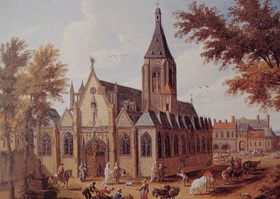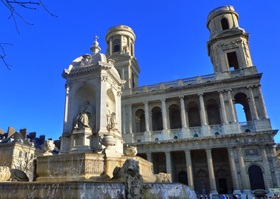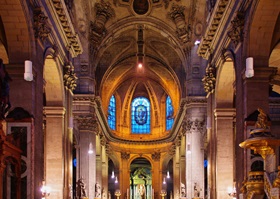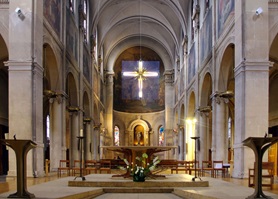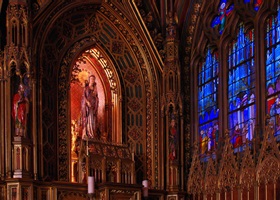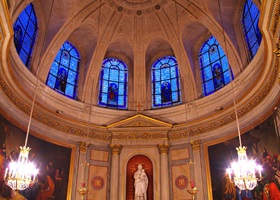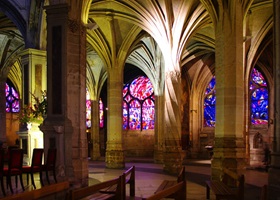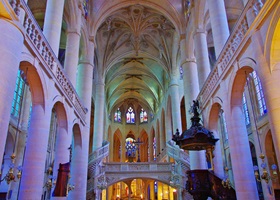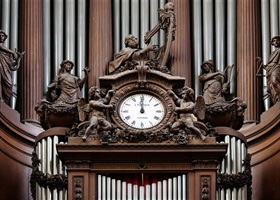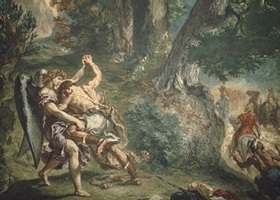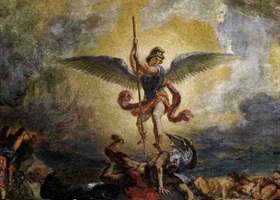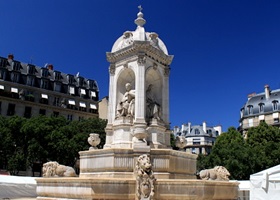Saint-Sulpice Church
The oldest vestiges of the Saint-Sulpice Church (Église du Saint-Sulpice), the base of the bell tower, date back from the 12th century. The church was originally dedicated to bishop Saint-Sulpice le bon (570-674), whose father kept him from his religious vocation until he was forty.
A small country church, it was enlarged three times, in the 14th, 15th and 17th centuries (1615 and 1631).
Following these works, it was still a bit small: 56 meters-long, 27-meters large, which is barely a fourth of what the Saint-Sulpice church is like now.
In 1642, priest Jean-Jacques Olier (1608-1657) took charge of the Saint-Sulpice church. The small antiquated church constrated a lot with the Palais du Luxemboug, located close by and built by Marie de Médicis. Although it had been enlarged, the church was still too small to accommodate the ever-growing population.
Olier immediately decided the construction of a new church, on plans designed by the king’s architect, Christophe Gamard.
The plans were approved in 1645. Identical to other large French sanctuaries built since 1000, the plan was original in its dimensions, which made Saint-Sulpice the largest church in Paris.
On February 20th 1646, regent Anne d’Autriche (Louis XIII’s widow) set the first stone her son, king Louis XIV, who was only eight.
The works started with the Virgin chapel, besides the old church. Gamard died in 1654, having only finished the bottom of the walls of this chapel. Louis Le Vau (1612-1686), first architect of the king, chosen to finish the building, was too involved in other construction sites to seriously manage Saint-Sulpice.
That’s why Daniel Gittard, a student and a colleague of Louis Le Vau, took charge of the construction site. They followed precisely the detailed plans he designed in 1660, with no significant modification until the building was completed - except for the facade. He actually was the true architect of the Saint-Sulpice church.
The inner space is a perfect example of the French classical style of the 17th century. Gittard could only design the choir himself, with the beautiful stained glass, installed in 1672 and 1673, and the north brace of the transept.
In 1678, the parish went bankrupt, which interrupted the works.
In 1714, Jean-Baptiste Languet de Gergy (1675-1750) was named priest of Saint-Sulpice. Following donation calls and a lottery, the priest gathered enough money to resume the works starting in 1719.
Designer Gilles-Marie Oppenord (1675-1742), a student of Jules-Hardouin de Mansart, took charge of the construction site. He followed the plans designed sixty years ago by Gittard: the cross-vaulted transept, the southern brace in 1723, the aisles in 1724, the nave and the inner decoration in 1731.
Sculptor Edme Bouchardon (1698-1762), author of the famous "Fountain of the four seasons", located at the 59, rue de Grenelle in paris, received an order for the statues decorating the pillars surrounding the choir (Christ on the column, the aching Virgin and the eight apostles).
Ninety-nine years after the first stone was set, Jean-Baptiste Languet de Gergy finally had the joy to witness the solemn consecration on June 30th 1745.
During the consecration, the facade and a great part of the inner decoration was missing.
A first contest saw Jean-Nicolas Servandoni (1695-1766) to build the central part, made of a gorgeous peristyle and an Italian-style loggia on the second floor. He couldn’t finish the crowning he had planned, and the works stopped.
In 1776, Jean-François Chalgrin (architect of the Arc de Triomphe) to raise the two tower, started by architect Oudot de Maclaurin, named during a second contest in 1677.
He executed the works asked on the northern tower (the one on the left), but the Revolution put a stop to the other tower’s works. It remained less high of five meters, and its sculpted decor was but a rough draft of what it was supposed to be.
At that time, the Eglise Saint-Sulpice was very damaged, such as many religious buildings in Paris. The master-altar was destroyed, the chapels’ altars, the stalls, the statues, the paintings and the bells were stolen, the valuable items were looted, the crypts’ sepultures violated and thousands of human bones were spread across the floor.
In 1802, priest Charles de Pierre (1762-1836) decided to give back its former glory to the Saint-Sulpice church, which was supposed to accommodate Pope Pie VII in Paris to bless the crowning of Emperor Napoléon I.
De Pierre found back some statues, paintings and bought back many items, but he had to wait until Restoration, in 1815, to be able to give back to Saint-Sulpice its former lustre.
In 1824, he had a new white marble master-altar built. The large bas-relief in golden bronze and all the other objects in the same metal form around the alter a beautiful ensemble that were made by goldsmith Louis-Isidore Choiselat (1784-1853).
Between 1845 and 1875, the city of Paris commanded 17 renowned painters to decorate the walls of the transept and all the chapels, among them the gorgeous ensemble made from 1850 to 1861, by Eugene Delacroix (1798-1863) in the chapelle des Saints Anges.
In the 19th century, another major asset came: the great organ, a work of art by Aristide Cavaillé-Coll (1811-1899), which enlarged and modernized the excellent instrument designed by Clicquot.
Information: architect Louis Visconti (1791-1853) realized the fountain Saint-Sulpice from 1844 to 1847.
Open every day, 8am-7pm.
Guided tour: every Sat and Sun at 3pm.
Organ concert: one Sun per month at 4pm.
Rate: free entrance.
How to get there: 2 Rue Palatine, 75006 Paris.
Métro line 4 Station "Saint-Sulpice".
Bus lines: 63, 70, 86, 87 and 96.








